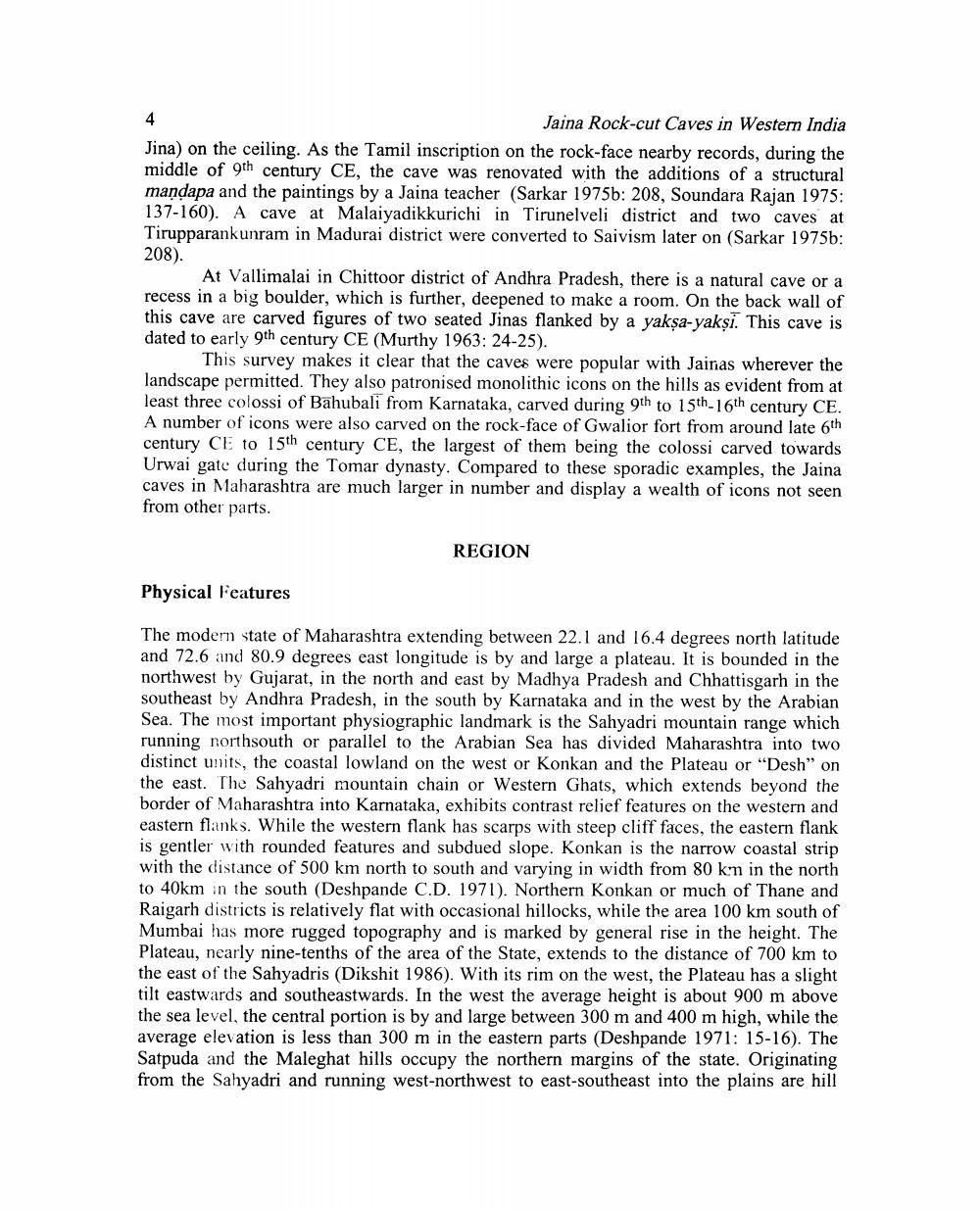________________
4
Jaina Rock-cut Caves in Western India Jina) on the ceiling. As the Tamil inscription on the rock-face nearby records, during the middle of 9th century CE, the cave was renovated with the additions of a structural mandapa and the paintings by a Jaina teacher (Sarkar 1975b: 208, Soundara Rajan 1975: 137-160). A cave at Malaiyadikkurichi in Tirunelveli district and two caves at Tirupparankunram in Madurai district were converted to Saivism later on (Sarkar 1975b:
208).
At Vallimalai in Chittoor district of Andhra Pradesh, there is a natural cave or a recess in a big boulder, which is further, deepened to make a room. On the back wall of this cave are carved figures of two seated Jinas flanked by a yakṣa-yakṣi. This cave is dated to early 9th century CE (Murthy 1963: 24-25).
This survey makes it clear that the caves were popular with Jainas wherever the landscape permitted. They also patronised monolithic icons on the hills as evident from at least three colossi of Bahubali from Karnataka, carved during 9th to 15th-16th century CE. A number of icons were also carved on the rock-face of Gwalior fort from around late 6th century CE to 15th century CE, the largest of them being the colossi carved towards Urwai gate during the Tomar dynasty. Compared to these sporadic examples, the Jaina caves in Maharashtra are much larger in number and display a wealth of icons not seen from other parts.
REGION
Physical Features
The modern state of Maharashtra extending between 22.1 and 16.4 degrees north latitude and 72.6 and 80.9 degrees east longitude is by and large a plateau. It is bounded in the northwest by Gujarat, in the north and east by Madhya Pradesh and Chhattisgarh in the southeast by Andhra Pradesh, in the south by Karnataka and in the west by the Arabian Sea. The most important physiographic landmark is the Sahyadri mountain range which running northsouth or parallel to the Arabian Sea has divided Maharashtra into two distinct units, the coastal lowland on the west or Konkan and the Plateau or "Desh" on the east. The Sahyadri mountain chain or Western Ghats, which extends beyond the border of Maharashtra into Karnataka, exhibits contrast relief features on the western and eastern flanks. While the western flank has scarps with steep cliff faces, the eastern flank is gentler with rounded features and subdued slope. Konkan is the narrow coastal strip with the distance of 500 km north to south and varying in width from 80 km in the north to 40km in the south (Deshpande C.D. 1971). Northern Konkan or much of Thane and Raigarh districts is relatively flat with occasional hillocks, while the area 100 km south of Mumbai has more rugged topography and is marked by general rise in the height. The Plateau, nearly nine-tenths of the area of the State, extends to the distance of 700 km to the east of the Sahyadris (Dikshit 1986). With its rim on the west, the Plateau has a slight tilt eastwards and southeastwards. In the west the average height is about 900 m above the sea level, the central portion is by and large between 300 m and 400 m high, while the average elevation is less than 300 m in the eastern parts (Deshpande 1971: 15-16). The Satpuda and the Maleghat hills occupy the northern margins of the state. Originating from the Sahyadri and running west-northwest to east-southeast into the plains are hill




